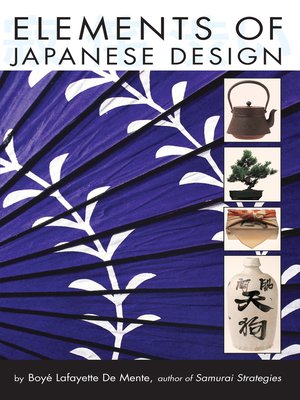
Sign up to save your library
With an OverDrive account, you can save your favorite libraries for at-a-glance information about availability. Find out more about OverDrive accounts.
Find this title in Libby, the library reading app by OverDrive.



Search for a digital library with this title
Title found at these libraries:
| Library Name | Distance |
|---|---|
| Loading... |
Learn the elements of the timeless beauty that is Japanese design in this concise reference volume.
Japanese design is known throughout the world for its beauty, its simplicity, and its blending of traditional and contemporary effects. This succinct guide describes the influence and importance of 65 key elements that make up Japanese design, detailing their origins—and their impact on fields ranging from architecture and interior design to consumer products and high fashion.
Learn, for example, how the wabi sabi style that's so popular today developed from the lifestyle choices made by monks a thousand years ago. And how unexpected influences—like tatami (straw mats) or seijaku (silence)—have contributed to contemporary Japanese design.
Elements of Japanese Design offers new insights into the historical and cultural developments at the root of this now international aesthetic movement. From wa (harmony) to kaizen (continuous improvement), from mushin (the empty mind) to mujo (incompleteness), you'll discover how these elements have combined and evolved into a powerful design paradigm that has changed the way the world looks, thinks and acts.
Chapters include:Washi, Paper with Character Ikebana, Growing Flowers in a Vase Bukkyo, The Impact of Buddhism Shibui, Eliminating the Unessential Kawaii, The Incredibly "Cute" Syndrome Katana, Swords with Spirit
Japanese design is known throughout the world for its beauty, its simplicity, and its blending of traditional and contemporary effects. This succinct guide describes the influence and importance of 65 key elements that make up Japanese design, detailing their origins—and their impact on fields ranging from architecture and interior design to consumer products and high fashion.
Learn, for example, how the wabi sabi style that's so popular today developed from the lifestyle choices made by monks a thousand years ago. And how unexpected influences—like tatami (straw mats) or seijaku (silence)—have contributed to contemporary Japanese design.
Elements of Japanese Design offers new insights into the historical and cultural developments at the root of this now international aesthetic movement. From wa (harmony) to kaizen (continuous improvement), from mushin (the empty mind) to mujo (incompleteness), you'll discover how these elements have combined and evolved into a powerful design paradigm that has changed the way the world looks, thinks and acts.
Chapters include:







